You can boost your cellular energy production through strategic heat therapy that enhances mitochondrial function. These tiny powerhouses in your cells work harder when exposed to controlled heat (40-42°C), increasing ATP generation by up to 28%. Just two hours of daily heat exposure triggers adaptations similar to exercise, including higher mitochondrial counts and improved respiratory capacity. It's especially beneficial if you can't exercise regularly, as passive heat treatments can enhance your metabolic efficiency without physical exertion. The science behind heat therapy's impact on mitochondrial performance reveals promising pathways to better health and energy levels.
The Powerhouse Within Our Cells
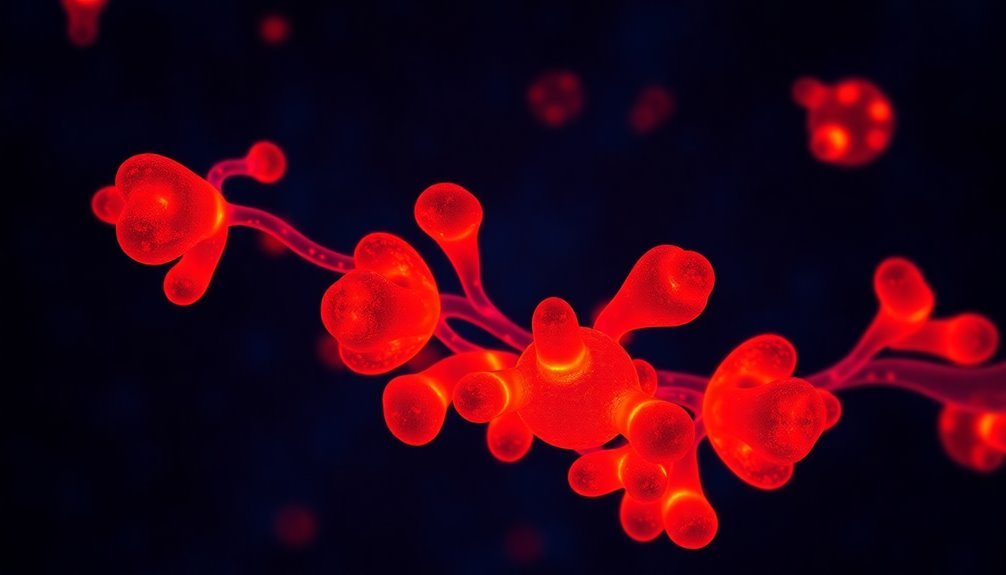
Within every cell of your body lies a remarkable organelle that powers nearly all of life's essential functions: the mitochondrion. These microscopic powerhouses feature a sophisticated double-membrane structure that's essential for their energy-producing capabilities. The outer membrane acts as a permeable gateway, while the inner membrane's tight control maintains the precise conditions needed for ATP production.
You'll find the inner membrane folded into numerous cristae, dramatically increasing the surface area where energy production takes place. Inside the innermost compartment, called the matrix, you'll discover a hub of activity containing specialized enzymes, unique mitochondrial DNA, and ribosomes.
What's fascinating is that these organelles aren't static – they're constantly moving and changing shape to meet your cells' energy demands. The Mitochondria-Associated ER Membrane helps facilitate essential calcium signaling and lipid metabolism between mitochondria and the endoplasmic reticulum.
The number of mitochondria in your cells varies depending on the tissue type and its energy requirements. For instance, your muscle cells contain more mitochondria than skin cells because they need more energy for contraction.
These organelles work tirelessly to produce ATP, store calcium, and even help regulate cell death, making them truly indispensable for your survival.
Heat Therapy Benefits Mitochondria
Your body's mitochondria respond dynamically to temperature changes, using specialized control mechanisms to maintain ideal function during heat exposure.
A recent study showed that two hours of heat applied daily produced significant improvements in mitochondrial function.
When you undergo heat therapy, these cellular powerhouses ramp up their energy production pathways, leading to enhanced ATP generation and improved metabolic efficiency.
The repeated application of therapeutic heat triggers lasting cellular adaptations, including increased mitochondrial numbers and enhanced respiratory capacity, much like the benefits you'd get from regular exercise.
Mitochondrial Temperature Control Mechanisms
Mitochondria's remarkable ability to maintain temperatures up to 15°C above ambient conditions showcases their sophisticated temperature control mechanisms. These cellular powerhouses use oxidative phosphorylation (OXPHOS) to generate heat while responding dynamically to your body's metabolic demands. Advanced measurement techniques like Mito Thermo Yellow enable precise tracking of these temperature variations.
You'll find that mitochondrial temperature regulation relies heavily on specific biochemical pathways. When you experience metabolic stress, such as substrate starvation or exposure to respiratory poisons, your mitochondria adjust their heat production accordingly. The adenine nucleotide translocase (ANT) plays an essential role in this regulation, while different inhibitors of the OXPHOS chain affect temperature to varying degrees.
Your mitochondria maintain ideal temperatures through several backup systems. Even when faced with respiratory poisons, they can activate alternative oxidase pathways to keep temperatures elevated. This precise control is vital because temperature fluctuations affect membrane fluidity and enzyme activity.
If temperatures rise too high, you'll see decreased ATP production and increased reactive oxygen species (ROS) generation. That's why your mitochondria work tirelessly to keep temperatures within a narrow range, adjusting their output based on available nutrients like glucose and glutamine.
Heat Activates Energy Production
Building on our understanding of mitochondrial temperature control, heat therapy emerges as a powerful tool for enhancing cellular energy production. When you expose your muscles to controlled heat stress, you're actually triggering a remarkable boost in mitochondrial function.
Research shows that six weeks of localized heat therapy can improve your mitochondrial respiratory capacity by nearly 25%, matching the benefits you'd get from exercise training. Interestingly, this improvement occurs without increasing fatty acid oxidation, unlike exercise training.
Heat therapy activates your cells' energy production through several key mechanisms that enhance mitochondrial performance:
- Increases the concentration of mitochondrial proteins in your skeletal muscle
- Stimulates mitochondrial biogenesis, creating more energy-producing units
- Improves respiratory capacity and insulin sensitivity
You don't need to exercise to reap these benefits – passive heat exposure can effectively preserve muscle mass and boost mitochondrial metabolism.
This makes heat therapy particularly valuable if you're unable to exercise due to injury or illness. The process works by activating specific signaling pathways that promote mitochondrial health and function, similar to high-intensity interval training.
For those with chronic conditions like type 2 diabetes or heart disease, heat therapy offers a promising avenue for improving cellular energy production.
Cellular Adaptations After Heat
Ever wonder how heat therapy transforms your cells at a microscopic level? When you expose your body to therapeutic heat, your mitochondria – the cellular powerhouses – undergo remarkable adaptations. Research shows that consistent heat therapy can boost mitochondrial function in your muscles by up to 28%. Recent studies have found that heat-stressed myoblasts experience significant changes in mitochondrial membrane potential.
These improvements occur through several key mechanisms. Heat stress triggers an increase in mitochondrial proteins and enhances their respiratory capacity. You'll find higher concentrations of mitochondrial complex proteins in heated muscles, indicating improved biogenesis – the creation of new mitochondria. This enhanced mitochondrial content helps your cells produce energy more efficiently.
What's particularly exciting is that you don't need to exercise to gain these benefits. If you can't exercise due to health limitations, heat therapy offers an alternative pathway to improve mitochondrial health. It's proven effective in treating various conditions, including type 2 diabetes and muscle atrophy.
However, you'll need to be careful with temperature levels. While beneficial adaptations occur at moderate temperatures, excessive heat above 43°C can damage mitochondria and trigger cell death. The key lies in finding the right balance of temperature and duration for ideal results.
Cellular Energy Production Process
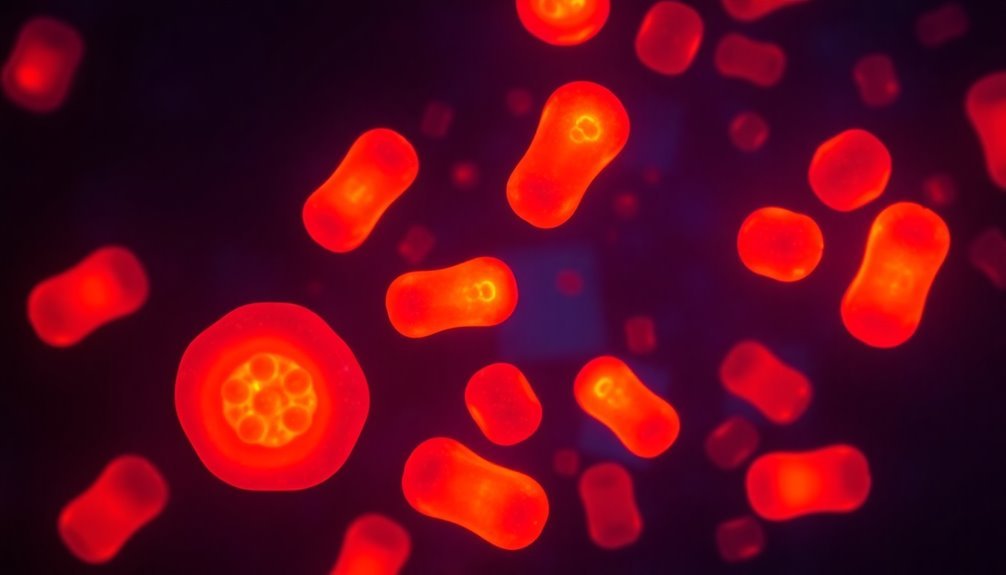
The production of cellular energy follows a remarkable three-stage process that transforms glucose into ATP, your body's primary energy currency.
It begins with glycolysis in your cell's cytoplasm, where a single glucose molecule splits into two pyruvate molecules, generating your first 2 ATP molecules.
These pyruvates then enter your mitochondria's matrix, where the citric acid cycle breaks them down further while producing NADH and FADH2. Nature Made B-Complex supplements can support these vital energy production processes.
The final and most productive stage occurs in your mitochondria's inner membrane through oxidative phosphorylation.
Here's what makes this stage essential:
- Uses the electron transport chain to generate most of your cellular ATP
- Produces up to 32 ATP molecules from a single glucose molecule
- Requires oxygen as the final electron acceptor, making it an aerobic process
Your mitochondria's ability to efficiently complete these processes directly impacts your body's energy levels.
Each stage builds upon the previous one, creating a sophisticated energy production system that powers everything from muscle contractions to nerve signaling.
The B vitamins in your diet play a fundamental role in supporting these energy-producing pathways.
Temperature Effects On ATP Generation
Your mitochondria's ATP generation is closely tied to temperature, with these cellular powerhouses maintaining an internal temperature about 15°C above their surroundings.
When you expose your cells to therapeutic heat, you'll notice increased ATP production up to an ideal point, as mitochondria respond to controlled temperature elevations by ramping up their energy-producing capacity.
However, you need to be careful not to exceed the ideal temperature range, since excessive heat can decrease ATP synthesis efficiency and trigger harmful reactive oxygen species production. The presence of alternative oxidase pathways helps maintain mitochondrial temperature even when exposed to respiratory inhibitors.
Heat Amplifies ATP Production
According to recent research, mitochondrial heat plays a crucial role in amplifying ATP production through enhanced oxidative phosphorylation. These cellular powerhouses maintain temperatures up to 15°C above their surroundings, creating ideal conditions for energy generation. You'll find that this elevated temperature isn't just a byproduct – it's critical for efficient ATP synthesis and cellular function. Local thermal gradients help initiate site-specific reactions throughout the cell's metabolic processes.
When you expose your muscles to heat therapy, you're triggering several beneficial adaptations in your mitochondria. The respiratory chain becomes more efficient, and your cells develop enhanced thermogenic pathways.
Here's what happens during heat-induced ATP amplification:
- The expression of UCP1 increases in brown adipocytes, boosting both heat and ATP production
- SERCA and actin-myosin complexes contribute to enhanced energy generation
- Mitochondrial temperature homeostasis maintains consistent ATP output
You should know that these effects are particularly pronounced in skeletal muscle, where repeated heat exposure leads to improved mitochondrial adaptation.
Daily heat treatment can help maintain mitochondrial function and prevent muscle atrophy during periods of immobilization. While the exact mechanisms aren't fully understood, the connection between heat and increased ATP production is well-documented through various research studies.
Optimal Temperature For Mitochondria
Building on our understanding of heat's role in ATP production, specific temperature ranges directly impact mitochondrial performance and efficiency. Research shows that mitochondria operate most effectively within distinct temperature windows, which vary among different species. For instance, in B. bufo, the ideal range falls between 20-30°C, where you'll see enhanced ATP synthesis and oxygen consumption rates. Extreme thermal events can pose serious risks to ectothermic organisms.
You'll notice that temperature affects multiple aspects of mitochondrial function. As temperatures rise within the ideal range, ATP production increases, though there's a trade-off: mitochondrial coupling efficiency tends to decrease. This balance is significant because approximately 40% of temperature's effects on ATP production stem from changes in mitochondrial oxidative capacity.
Your mitochondria can maintain temperatures up to 15°C above the surrounding environment in cultured cells, demonstrating remarkable temperature homeostasis. However, you'll want to avoid excessive heat exposure, as it can trigger increased ROS (reactive oxygen species) production, particularly during active phosphorylation.
Different organisms have adapted to various temperature ranges – for example, Mya arenaria functions best between 5-15°C, showing how evolution has enhanced mitochondrial performance for specific environmental conditions.
Exercise Versus Heat Treatment
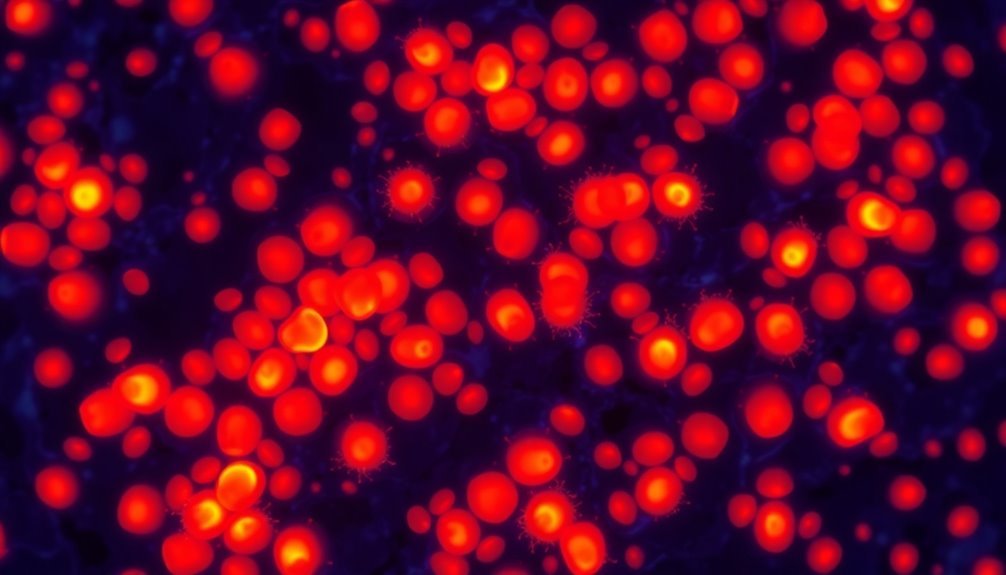
Recent studies looking into both exercise and heat therapy have revealed fascinating parallels in their effects on mitochondrial health. You'll find that both interventions can boost your mitochondrial respiratory capacity by roughly 25%, making them valuable tools for improving cellular energy production. HIIT workouts show more significant benefits for mitochondrial adaptation compared to steady-state exercise.
While there's overlap in some benefits, exercise stands out as the more thorough intervention. It's the only one that increases fatty acid oxidation and citrate synthase activity, indicating a broader impact on your mitochondrial function.
However, don't dismiss heat therapy – it's proven particularly valuable if you can't exercise due to physical limitations.
Key differences between exercise and heat therapy include:
- Exercise generates multiple forms of stress that trigger mitochondrial biogenesis, while heat therapy works through temperature-specific pathways
- Only exercise increases mitochondrial content, as measured through citrate synthase activity
- Heat therapy can serve as an alternative when physical activity isn't possible, offering some but not all of exercise's benefits
Understanding these distinctions helps you make informed choices about using either or both interventions to support your mitochondrial health, depending on your specific circumstances and capabilities.
Mitochondrial Adaptations Through Heat
Now that you understand the key differences between exercise and heat therapy, let's explore how heat specifically transforms your mitochondria. When you undergo heat therapy, your mitochondrial respiratory capacity improves by nearly 25%, enhancing your cells' ability to produce energy. This adaptation occurs primarily through the activation of heat shock proteins, particularly HSP72, which play an important role in protecting and modifying your mitochondria.
While heat therapy won't increase your mitochondrial protein content or improve fatty acid oxidation like exercise does, it offers unique benefits through different pathways. Your body responds to heat stress by coordinating various signaling molecules, transcription factors, and molecular chaperones that work together to enhance mitochondrial function.
You'll see the best results with repeated exposure to mild heat stress, whether through localized or whole-body heating.
The therapeutic potential of heat therapy is particularly promising if you're dealing with metabolic issues. It can improve your insulin sensitivity and help preserve muscle mass during periods of inactivity. You don't need intense exercise to achieve these benefits – passive heating can effectively trigger these beneficial mitochondrial adaptations.
Disease Prevention Through Heat Therapy
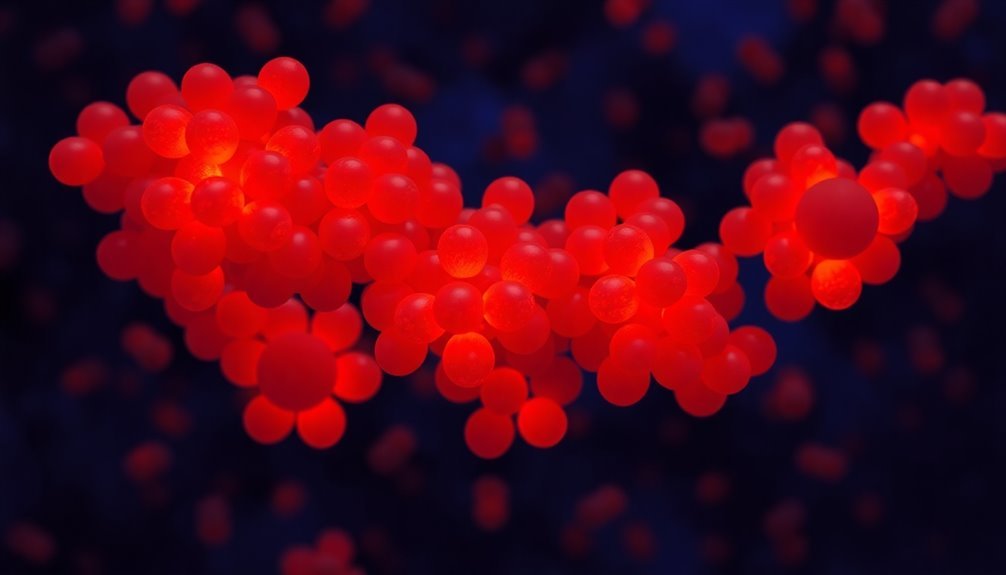
Your body's disease-fighting mechanisms get a boost when you use targeted heat therapy at specific therapeutic temperatures.
You'll achieve peak prevention when maintaining temperatures between 100-104°F (37.8-40°C), as this range effectively blocks various disease pathways through enhanced mitochondrial function.
When you apply heat therapy consistently within these target zones, you're supporting your cellular health while activating protective mechanisms that help prevent chronic conditions.
Heat Blocks Disease Pathways
Through the remarkable mechanisms of heat therapy, the body's natural defense systems activate to prevent various diseases and combat harmful cellular processes. When you expose yourself to therapeutic heat, your body produces heat shock proteins (HSPs), which play a vital role in preventing protein misfolding and aggregation – common factors in neurodegenerative diseases like Alzheimer's.
Heat therapy's disease-blocking effects work through multiple pathways that directly impact your health:
- It triggers vasodilation, improving blood flow and reducing chronic inflammation throughout your body.
- It enhances cellular respiration and vascular function, strengthening your metabolic health.
- It blocks pain signals through thermal receptors while improving muscle function.
You'll find that regular heat exposure, such as sauna bathing, can greatly reduce your risk of developing various chronic conditions. The therapy improves markers of metabolic health and cardiovascular function while enhancing tissue metabolism and healing processes.
However, you'll need to exercise caution if you have certain conditions like diabetes or deep vein thrombosis. It's important to avoid heat therapy immediately after injuries or during infections, and you should always consult your healthcare provider if you have pre-existing conditions.
Therapeutic Temperature Target Zones
While heat therapy's disease-blocking effects are powerful, achieving ideal results requires precise temperature control. You'll want to target temperatures between 40°C and 45°C (104°F to 113°F) for best therapeutic benefits. At these levels, you're promoting increased blood flow and tissue healing without risking damage.
| Temperature Range | Effects | Applications |
|---|---|---|
| Below 40°C | Safe, minimal therapeutic effect | Gentle warming |
| 40°C – 45°C | Best healing, increased blood flow | Muscle strains, arthritis |
| Above 45°C | Risk of tissue damage, avoid | Not recommended |
You can safely apply heat therapy for 15-20 minute sessions using various methods like heating pads or warm baths. If you're using precision-controlled heating devices, you'll get more consistent results and better safety. It's important to monitor your skin's response during treatment – if you experience discomfort, reduce the temperature immediately.
For specific conditions like cardiac arrest or traumatic brain injury, you'll need professional supervision for targeted temperature management. Remember that while home heat therapy is generally safe, you should consult healthcare providers to determine the most appropriate temperature settings for your situation.
Optimizing Mitochondrial Function
Several powerful strategies exist for improving mitochondrial function, ranging from targeted exercise protocols to lifestyle modifications.
You'll get the most significant benefits by combining high-intensity interval training (HIIT) with resistance training, as these exercises directly stimulate mitochondrial biogenesis and enhance your cells' energy production capacity.
Your lifestyle choices play an essential role in maintaining peak mitochondrial health.
Quality sleep and stress management techniques aren't just good for your mental well-being – they're vital for mitochondrial recovery and function. When you're well-rested, your body can efficiently remove neural waste and maintain healthy mitochondrial processes.
To support your mitochondria at the cellular level, focus on these key nutritional strategies:
- Incorporate CoQ10 and B vitamins to enhance energy production
- Add omega-3 fatty acids to combat oxidative stress
- Include resveratrol-rich foods to promote mitochondrial biogenesis
Passive Heat Treatment Methods
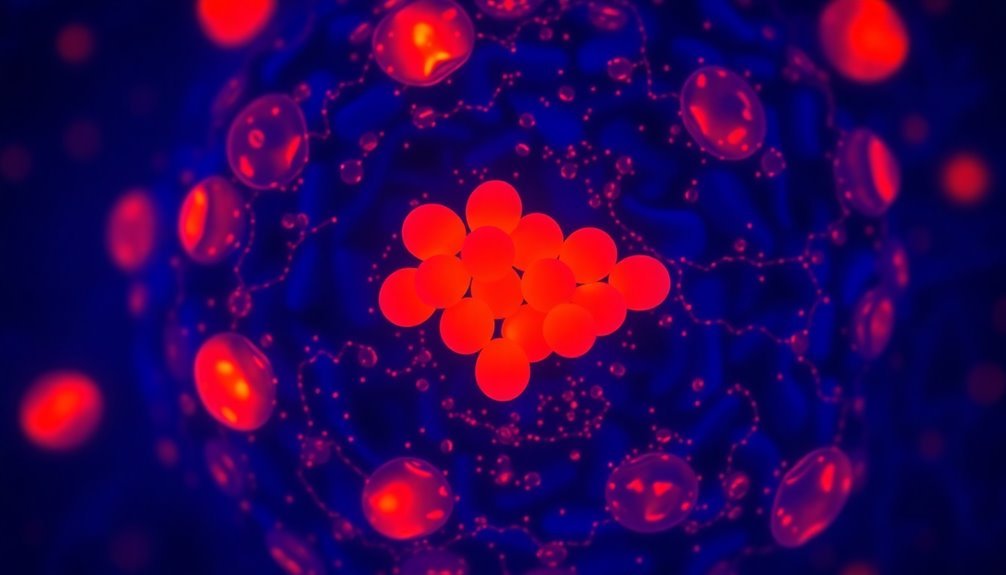
Passive heat treatment stands out as a powerful method for enhancing mitochondrial function up to 30% without the need for physical exertion. You'll find several ways to apply this therapy, including short-wave diathermy, whole-body heating, and localized heat treatments using water baths or heated metal beads.
When you undergo heat therapy, your core temperature rises to 40-42°C, triggering a cascade of beneficial cellular responses. The duration can range from 20 minutes to 2 hours per session, depending on the specific protocol.
Your body's heat shock response kicks in, producing protective proteins that safeguard and enhance mitochondrial function.
You'll experience improvements in your mitochondrial respiratory capacity and enzyme content through both acute and chronic treatments. The therapy works by activating essential signaling pathways that promote mitochondrial biogenesis and enhance overall cellular energy production.
If you can't exercise due to injury or illness, heat treatment offers a viable alternative for maintaining mitochondrial health. While researchers continue to study effective protocols, you can benefit from this non-invasive approach to boost your cellular energy production and metabolic health.
Metabolic Health Through Heat
Beyond its direct effects on mitochondrial function, heat therapy offers remarkable benefits for your overall metabolic health. Through the activation of TRPV1 proteins, heat exposure initiates a process called futile calcium cycling, which boosts your energy expenditure and enhances fat burning. You'll find this particularly beneficial if you're dealing with age-related weight gain or metabolic challenges.
Heat therapy's impact on your metabolism is multifaceted, working through several key mechanisms. Heat shock proteins play a vital role in improving glucose absorption while fighting inflammation.
You'll also experience positive changes in your muscle tissue through microvascular remodeling, which helps preserve muscle mass and function.
- Reduces fat accumulation in tissues and improves insulin sensitivity
- Preserves metabolically active brown fat, which naturally diminishes with age
- Helps prevent muscle atrophy through molecular stress response
If you're managing diabetes or dealing with menopausal weight changes, you'll find heat therapy particularly valuable. Regular sessions, whether through saunas or heated baths, can effectively combat insulin resistance and support your body's metabolic processes.
However, it's important to evaluate the ideal duration and intensity of heat exposure for your specific needs.
Research Breakthroughs In Heat Therapy
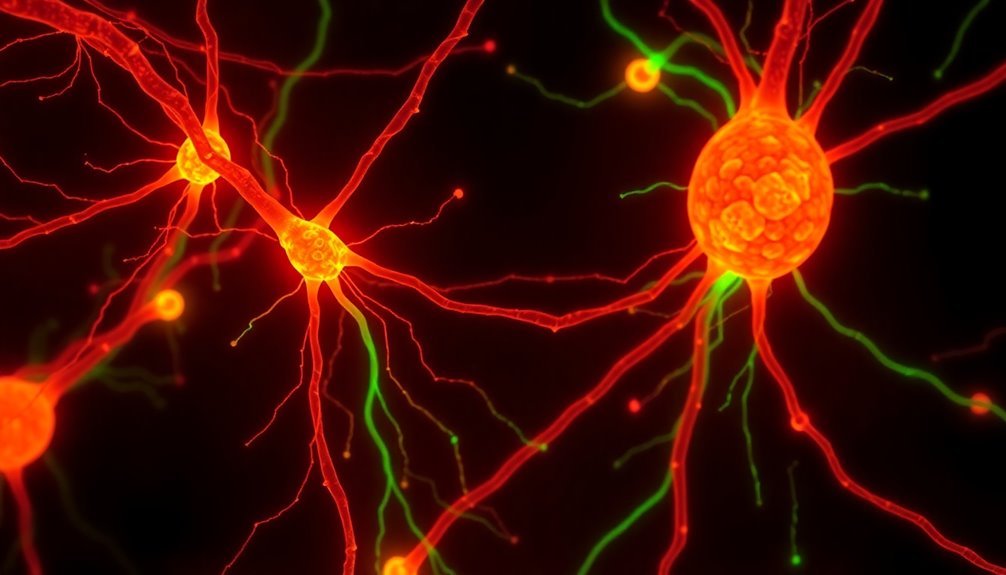
Recent breakthroughs in heat therapy research have revolutionized our understanding of mitochondrial adaptations. In 2018, researchers discovered that using short-wave diathermy to raise internal muscle temperature can increase mitochondrial respiratory capacity by nearly 30%. You'll find this particularly significant as it demonstrates heat's direct impact on cellular energy production.
When you're unable to exercise, heat therapy offers a promising alternative. Research shows it can prevent muscle atrophy and improve insulin sensitivity, making it valuable for treating conditions like type II diabetes and heart disease. You'll see similar benefits to exercise, though heat therapy doesn't enhance fatty acid oxidation or citrate synthase activity to the same extent.
The science behind these improvements involves complex cellular mechanisms. Heat stress triggers mitochondrial biogenesis through various signaling molecules and transcription factors.
While initial studies in cell cultures and animal models have shown promising results, you should know that researchers are still working to fully understand the mechanisms in humans. They're currently focused on optimizing treatment protocols and conducting larger clinical trials to establish the most effective approaches for different medical conditions.
Frequently Asked Questions
Can Heat Therapy Help With Weight Loss Through Increased Mitochondrial Activity?
While heat therapy boosts your mitochondrial function, it won't directly cause weight loss. However, it can support your weight loss efforts by improving glucose control and preventing muscle loss during diet and exercise.
How Does Altitude Affect Mitochondrial Response to Heat Therapy Treatments?
You'll find limited research on altitude's effects on heat therapy and mitochondria. While altitude increases mitochondrial density, and heat therapy boosts function, their combined impact isn't well-understood. You'll need more studies for clarity.
Do Certain Medications Interfere With Mitochondrial Benefits From Heat Therapy?
Yes, your medications can interfere with heat therapy benefits. Drugs affecting mitochondrial function, like CoQ10, idebenone, and thiamine, may alter the therapeutic effects. It's best to consult your doctor before combining treatments.
What Role Does Genetics Play in Individual Responses to Heat Therapy?
Your genetic makeup greatly influences how you'll respond to heat therapy. Your HSF genes and heat shock protein variations determine your heat tolerance, adaptation ability, and potential therapeutic benefits from heat exposure.
Can Combining Cold Therapy With Heat Improve Mitochondrial Function Further?
Yes, you'll likely see enhanced mitochondrial benefits by combining cold and heat therapy. While research is still limited, the different stress pathways activated by each treatment may work together to boost your mitochondrial function.
In Summary
You've learned how heat therapy can revolutionize your cellular energy production by enhancing mitochondrial function. Whether you're using saunas, hot baths, or other passive heating methods, you're helping your body generate ATP more efficiently. As research continues to reveal the benefits of controlled heat exposure, you'll find it's an accessible way to boost your metabolic health and optimize your cellular powerhouses – without breaking a sweat through exercise.

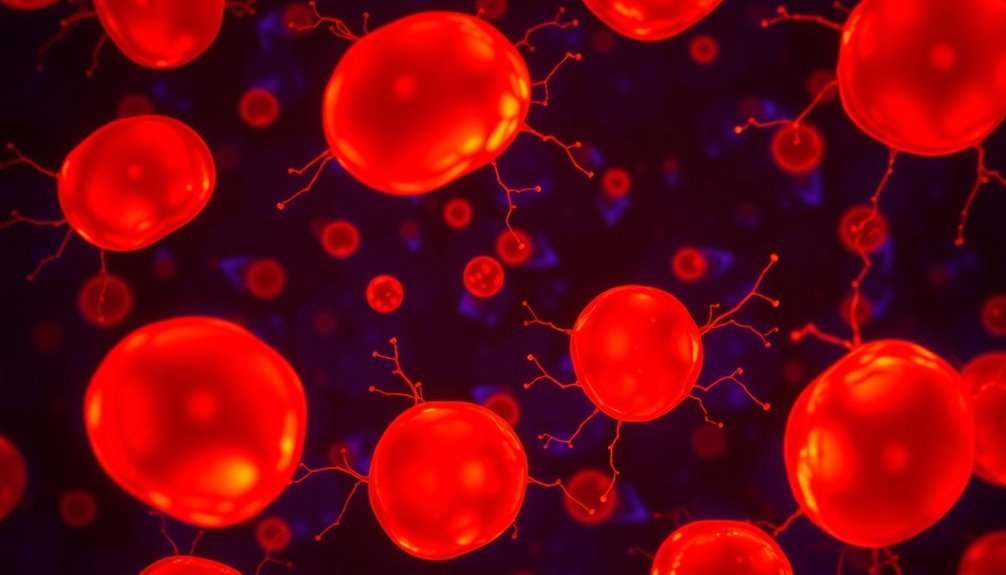



Leave a Reply